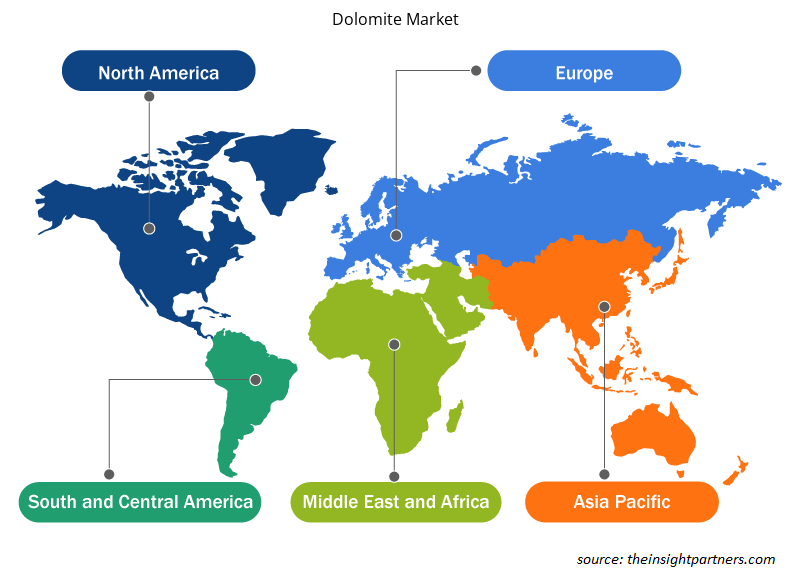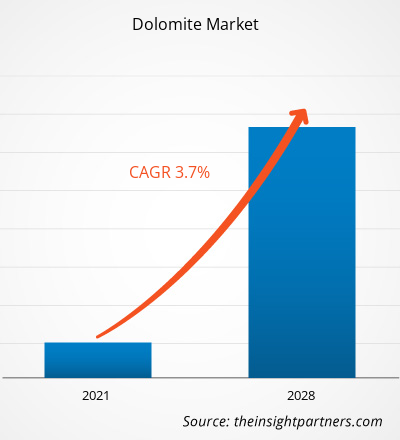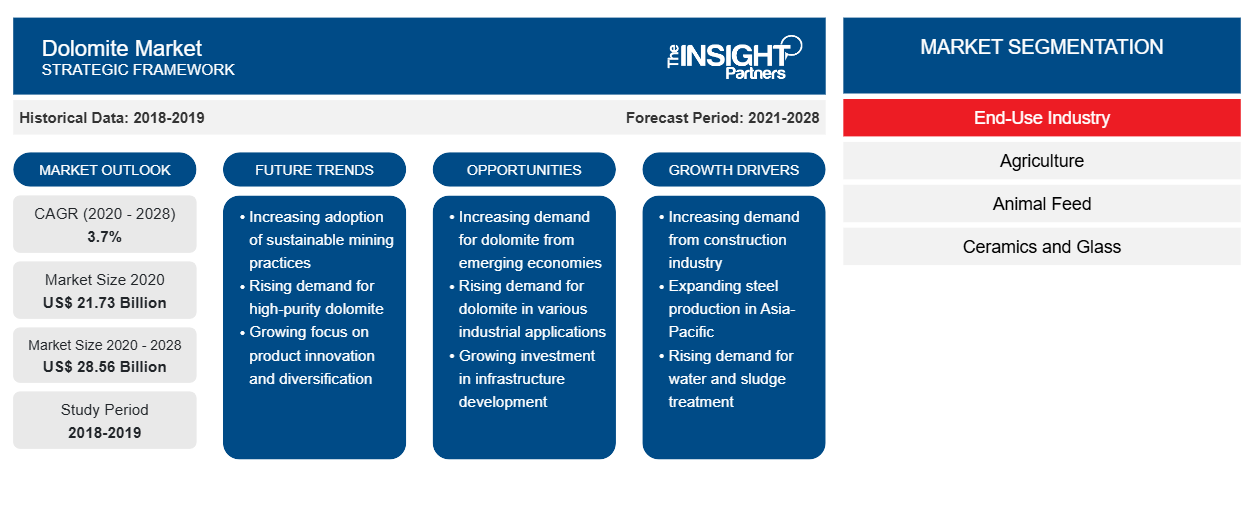Der Dolomitmarkt soll von 21.727,97 Millionen US-Dollar im Jahr 2020 auf 28.558,14 Millionen US-Dollar im Jahr 2028 wachsen; für den Zeitraum 2021–2028 wird eine durchschnittliche jährliche Wachstumsrate (CAGR) von 3,7 % erwartet.
Dolomit ist ein wichtiges Material für die Ferrolegierungsindustrie und wird häufig in Eisen- und Stahlwerken verwendet. Aufgrund seiner Fähigkeit, als Bodenverbesserer zu wirken und den pH-Wert des Bodens auszugleichen, findet es auch in der Landwirtschaft wichtige Anwendung. Öl und Gas, Chemikalien, Gummi, Bergbau und Metalle, Wasseraufbereitung, Pharmazeutika und Kosmetika sind weitere wichtige Endverbraucher dieser Substanz. Da diese Branchen ein beträchtliches Wachstum verzeichnen, insbesondere in Entwicklungsländern, wächst auch die Nachfrage nach Dolomit kontinuierlich. Die negativen Auswirkungen der Bergbauaktivitäten auf die Umwelt bleiben jedoch für die Dolomitproduzenten ein Problem.
Im Jahr 2020 hatte der asiatisch-pazifische Raum den größten Umsatzanteil am globalen Dolomitmarkt . Das schnelle Wachstum der Industrialisierung treibt Investitionen in die Verkehrsinfrastruktur dieser Region voran. Darüber hinaus treibt ein Anstieg der Feuerfestproduktion die Nachfrage nach Dolomit in der Eisen- und Stahlindustrie im asiatisch-pazifischen Raum an. Die Region beherbergt die größten Volkswirtschaften wie China und Indien, die zu den weltweit größten Verbrauchern von Feuerfestmaterialien gehören. China ist einer der größten Stahlproduzenten der Welt, während Indien ein exponentielles Wachstum seiner Infrastruktur erlebt. Diese Faktoren bieten den Akteuren auf dem Dolomitmarkt in der Region zahlreiche Wachstumschancen.
Passen Sie diesen Bericht Ihren Anforderungen an
Sie erhalten kostenlos individuelle Anpassungen an jedem Bericht, einschließlich Teilen dieses Berichts oder einer Analyse auf Länderebene, eines Excel-Datenpakets sowie tolle Angebote und Rabatte für Start-ups und Universitäten.
-
Holen Sie sich die wichtigsten Markttrends aus diesem Bericht.Dieses KOSTENLOSE Beispiel umfasst eine Datenanalyse von Markttrends bis hin zu Schätzungen und Prognosen.
Auswirkungen der COVID-19-Pandemie auf den Dolomitmarkt
Die anhaltende COVID-19-Pandemie hat den Status des Chemie- und Materialsektors drastisch verändert und sich negativ auf das Wachstum des Dolomitbergbaumarktes ausgewirkt. Die Umsetzung von Maßnahmen zur Bekämpfung der Ausbreitung von SARS-CoV-2 hat die Situation verschärft. Branchen wie das Baugewerbe sowie die Eisen- und Stahlindustrie sind von der plötzlichen Verzerrung der Betriebseffizienz und den Störungen der Wertschöpfungsketten betroffen, die auf die plötzliche Schließung nationaler und internationaler Grenzen zurückzuführen sind. Ein erheblicher Rückgang des Wachstums der verschiedenen Industriezweige hat zu einer geringeren Nachfrage nach Dolomit geführt. Die Schließung des Bergbaubetriebs hat zu einer beeinträchtigten jährlichen Produktionsleistung geführt. Die langfristigen Auswirkungen der COVID-19-Pandemie auf die Bergbauindustrie werden von der Länge der Sperrzeiten und der Fähigkeit der Akteure der Branche abhängen, wieder aufzuleben. Da viele Länder planen, ihren Betrieb wieder aufzunehmen, wird erwartet, dass die Nachfrage nach Dolomit in den kommenden Monaten weltweit steigen wird. Die Akteure des Dolomitbergbaumarktes konzentrieren sich auf die Verfügbarkeit von Lieferungen und Arbeitskräften, um das volle Betriebsniveau zu erreichen.
Markteinblicke
Breites Anwendungsspektrum von Dolomit fördert Wachstum auf dem Dolomitmarkt
Dolomit hat ein breites Anwendungsspektrum in Endverbraucherbranchen wie Bauwesen, Eisen und Stahl, Ferrolegierungen, Keramik und Glas, Landwirtschaft und Tierfutter. Seine Vorliebe und Verwendung in der Industrie hängt von der Qualität des Gesteins ab. Aufgrund seiner Härte und Dichte ist Dolomit ein häufig verwendeter Stoff in der Bauindustrie. In der Eisen- und Stahlindustrie wird Dolomit in drei Formen verwendet: Rohdolomit, kalzinierter Dolomit und gesinterter Dolomit. Dolomit wird in der chemischen Industrie zur Säureneutralisierung und bei Flussrenaturierungsprojekten verwendet. Außerdem dient er als Magnesia-Quelle (MgO), einem Futterzusatz für Nutztiere. Dolomit wird bei der Herstellung von Autoglas, Bauglas, Fiberglas usw. verwendet. Mit dem Wachstum verschiedener Endverbraucherbranchen wie Bauwesen, Eisen und Stahl sowie Keramik und Glas steigt also auch die Nachfrage nach Dolomit.
Einblicke in die Endverbraucherbranche
Basierend auf der Endverbrauchsindustrie ist der globale Dolomitmarkt in Landwirtschaft, Tierfutter, Keramik und Glas, Eisen und Stahl, Bauwesen und andere unterteilt. Das Segment Eisen und Stahl hatte im Jahr 2020 den größten Marktanteil. Die Eisen- und Stahlindustrie wird stark vom Wachstum von Segmenten wie Verteidigung, Schwermaschinenbau, Energie und Bauwesen getrieben. Die ständig steigende Nachfrage aus diesen Sektoren aufgrund der raschen Urbanisierung und Industrialisierung, insbesondere in Entwicklungsregionen wie dem asiatisch-pazifischen Raum sowie Süd- und Mittelamerika, ist ein wichtiger Faktor, der zur hohen Nachfrage nach Dolomit in der Welt beiträgt, was das Marktwachstum ankurbelt.
Einige der wichtigsten Marktteilnehmer auf dem globalen Dolomitmarkt sind Beihai Group, Calcinor, Essel Mining & Industries Limited, JFE GROUP, INCA MINING, LHOIST GROUP, Sibelco, RHI Magnesita GmbH, Arihant Min chem und Omya AG.
Regionale Einblicke in den Dolomitmarkt
Die regionalen Trends und Faktoren, die den Dolomitmarkt während des Prognosezeitraums beeinflussen, wurden von den Analysten von Insight Partners ausführlich erläutert. In diesem Abschnitt werden auch die Dolomitmarktsegmente und die Geografie in Nordamerika, Europa, im asiatisch-pazifischen Raum, im Nahen Osten und Afrika sowie in Süd- und Mittelamerika erörtert.

- Holen Sie sich die regionalspezifischen Daten für den Dolomitmarkt
Umfang des Dolomit-Marktberichts
| Berichtsattribut | Details |
|---|---|
| Marktgröße im Jahr 2020 | 21,73 Milliarden US-Dollar |
| Marktgröße bis 2028 | 28,56 Milliarden US-Dollar |
| Globale CAGR (2020 - 2028) | 3,7 % |
| Historische Daten | 2018-2019 |
| Prognosezeitraum | 2021-2028 |
| Abgedeckte Segmente |
Nach Endverbrauchsbranche
|
| Abgedeckte Regionen und Länder |
Nordamerika
|
| Marktführer und wichtige Unternehmensprofile |
|
Dichte der Marktteilnehmer für Dolomit: Deren Auswirkungen auf die Geschäftsdynamik verstehen
Der Dolomitmarkt wächst rasant, angetrieben durch die steigende Endverbrauchernachfrage aufgrund von Faktoren wie sich entwickelnden Verbraucherpräferenzen, technologischen Fortschritten und einem größeren Bewusstsein für die Vorteile des Produkts. Mit steigender Nachfrage erweitern Unternehmen ihr Angebot, entwickeln Innovationen, um die Bedürfnisse der Verbraucher zu erfüllen, und nutzen neue Trends, was das Marktwachstum weiter ankurbelt.
Die Marktteilnehmerdichte bezieht sich auf die Verteilung der Firmen oder Unternehmen, die in einem bestimmten Markt oder einer bestimmten Branche tätig sind. Sie gibt an, wie viele Wettbewerber (Marktteilnehmer) in einem bestimmten Marktraum im Verhältnis zu seiner Größe oder seinem gesamten Marktwert präsent sind.
Die wichtigsten auf dem Dolomitmarkt tätigen Unternehmen sind:
- Beihai-Gruppe
- Calcinor
- Essel Mining & Industries Limited
- JFE-Gruppe
- INKA-BERGBAU
Haftungsausschluss : Die oben aufgeführten Unternehmen sind nicht in einer bestimmten Reihenfolge aufgeführt.

- Überblick über die wichtigsten Akteure auf dem Dolomite-Markt
Bericht-Spotlights
- Fortschrittliche Branchentrends auf dem Dolomitmarkt helfen den Akteuren bei der Entwicklung wirksamer langfristiger Strategien
- In Industrie- und Entwicklungsländern angewandte Strategien für Unternehmenswachstum
- Quantitative Analyse des Dolomitmarktes von 2019 bis 2028
- Schätzung der weltweiten Nachfrage nach Dolomit
- Porters Fünf-Kräfte-Analyse zur Veranschaulichung der Wirksamkeit von Käufern und Lieferanten in der Branche
- Aktuelle Entwicklungen zum Verständnis des wettbewerbsorientierten Marktszenarios
- Markttrends und -aussichten sowie Faktoren, die das Wachstum des Dolomitmarktes bestimmen
- Unterstützung im Entscheidungsprozess durch Aufzeigen von Marktstrategien, die das kommerzielle Interesse untermauern und zum Marktwachstum führen
- Größe des Dolomitmarktes an verschiedenen Knotenpunkten
- Detaillierte Marktübersicht und -segmentierung sowie die Dynamik der Dolomitindustrie
- Größe des Dolomitmarktes in verschiedenen Regionen mit vielversprechenden Wachstumschancen
Der globale Dolomitmarkt wurde wie folgt segmentiert:
Nach Endverbrauchsbranche
- Landwirtschaft
- Tierfutter
- Keramik und Glas
- Eisen und Stahl
- Konstruktion
- Sonstiges
Firmenprofile
- Beihai-Gruppe
- Calcinor
- Essel Mining & Industries Limited
- JFE-Gruppe
- INKA-BERGBAU
- LHOIST-GRUPPE
- Sibelco
- RHI Magnesita GmbH
- Arihant Min Chemie
- OMV Immobilien AG
- Historische Analyse (2 Jahre), Basisjahr, Prognose (7 Jahre) mit CAGR
- PEST- und SWOT-Analyse
- Marktgröße Wert/Volumen – Global, Regional, Land
- Branchen- und Wettbewerbslandschaft
- Excel-Datensatz
Aktuelle Berichte
Erfahrungsberichte
Grund zum Kauf
- Fundierte Entscheidungsfindung
- Marktdynamik verstehen
- Wettbewerbsanalyse
- Kundeneinblicke
- Marktprognosen
- Risikominimierung
- Strategische Planung
- Investitionsbegründung
- Identifizierung neuer Märkte
- Verbesserung von Marketingstrategien
- Steigerung der Betriebseffizienz
- Anpassung an regulatorische Trends























 Kostenlose Probe anfordern für - Dolomitenmarkt
Kostenlose Probe anfordern für - Dolomitenmarkt